Previously we explored some reasons why a large tree might be found in the middle of a field, where it offers to the thoughtful eye a welcome dose of romance and mild mystery. Anyone with memories of lounging under such a tree, amid the whisper of wheat-shocks waving in the breeze and the darting dance of dragonflies, will understand something of the unique value they bring to the featureless agricultural plain. As a portal into the past, these long-lived monuments also offer an opportunity to grasp something of the passage of time, by preserving a peaceful scene that must have remained unchanged for a very long period — often, far longer than the meager span of our lives.
But to persist in the same context for generations is not the only way that a field tree can convey a broad perspective of time. It is just as intriguing to ponder an ancient tree that has persisted not by the benefit of benign neglect, but by survival of dramatic change — through the contrast it offers to the world that has sprung up around it.
Living with change
In this period of Western history, the dramatic change that Americans know best is arguably that of suburban sprawl. Seemingly everywhere we look, we see examples where a patchwork of field, forest and farmland has become a chessboard of investment and exploitation, often within our own lifetime. Even as the climate warms inexorably, and smoldering forests have now begun poisoning our air on an annual basis from thousands of miles away, property investors continue to pursue wealth as their parents did, by appropriating ever-larger swaths of forest and farmland for cancerous cul-de-sac communities and compulsively paved commercial strips — doubling down on a lifestyle that brought this crisis about, disproving its own claim to a perpetual future.
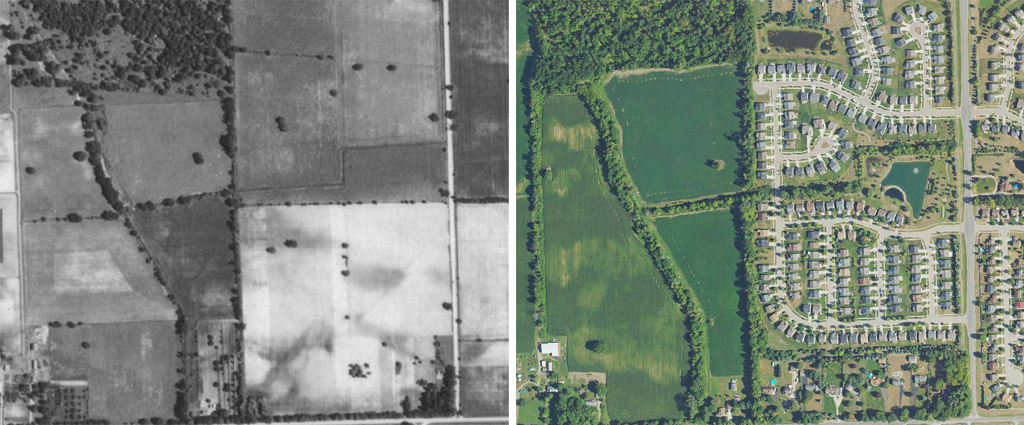
It is only because the world we are consuming is so rich with beautiful and evocative things that a few can occasionally slip through the cracks. With some effort, we can sometimes identify where these crumbs have fallen, and it is with these that we can still satisfy our need for a richer diet than concrete curbs and putting greens.
It could be a conservation easement, by a landowner who has neither denied his sense of stewardship nor constrained it to the brief span of his life. Or a mitigation requirement might force a developer to set aside an acre or two. More often it is simply luck and circumstance. Whatever the path, a small thing of beauty sometimes escapes the desperate tyranny of the profit-seeker, and persists — to reward those few who still have the patience and sensitivity to see.
The Traver Village hickory
The wayward hickory we see below, in residence at 2641 Plymouth Road in Ann Arbor, Michigan, was once a humble field tree. Both field and tree have since been reimagined, the first as a retail development, and the second as a postmodern ornament, adorning a sort of raised-bed planter.
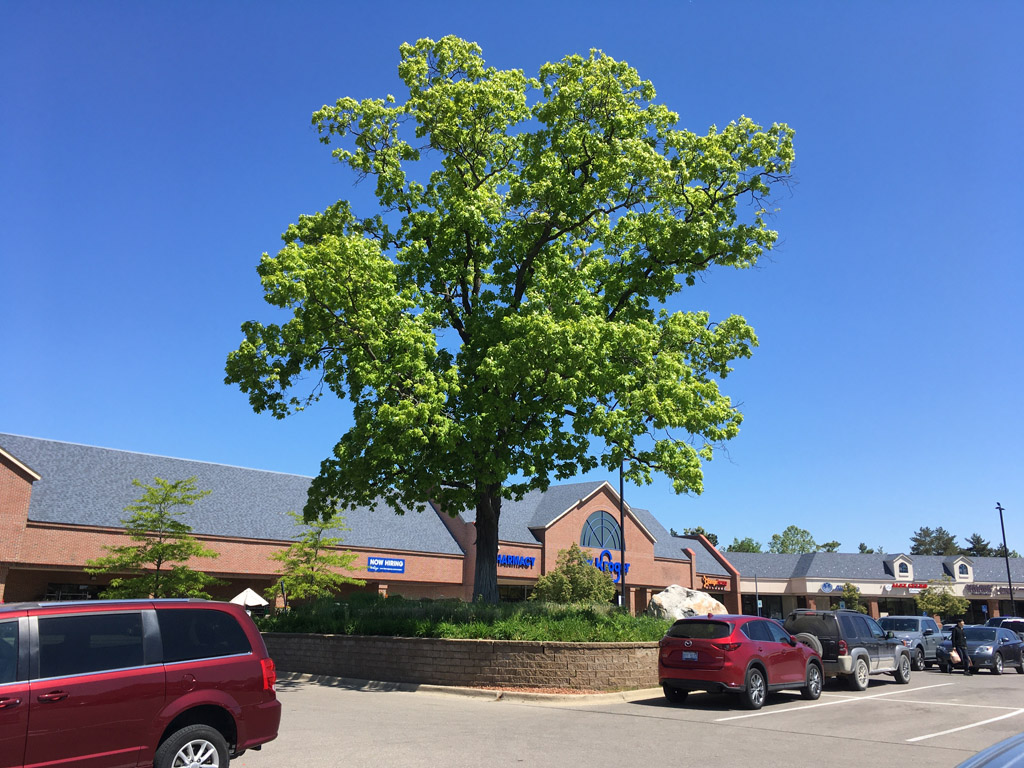
I can vaguely remember when this shopping center, named Traver Village, was built. Before greenwashing was a word, the developer apparently decided to keep this tree as a sort of ecological gesture — or more honestly, I thought, as an implicit apology for what was done here. At the time, I mentioned to a friend that this gesture would not persist for long, because the acres of impervious pavement that now surrounded the tree would lower the water table so much that it would die of thirst. Decades later, I am happy to stand corrected — whether by misjudgment, or by irrigation. What else can this tree’s journey teach us?
Now, in its second career as an object of curiosity, it happens to hold a key with which we can recover a rare and elusive image of a bygone world.
Older than it looks
The size of this probable Shagbark Hickory (Carya ovata) suggests that it is remarkably old. In an approximate way, the diameter of a tree’s trunk, measured at breast height (about 4-1/2 feet), can be translated to age by means of a growth factor (the approximate ratio of age in years to diameter in inches). Hickories have a relatively large growth factor of 7.5, meaning that skinny trees can be pretty old. Another common tree, white oak, has a growth factor of 5, while silver maple, a fast-growing native tree, has a growth factor of only 3. This means that if we see a silver maple and a shagbark hickory, each of which is 14 inches in diameter, the silver maple is probably about forty years old, while the shagbark could be more than a hundred. Of course, there are a lot of caveats — for example, a tree that grows out in the open may grow faster than a tree in a dense forest, and an urban tree has its own slate of difficulties. I’m just going to use the standard growth factor values here, because the ancient trees we will examine today probably have had a mixed history of forest, field, and street.
Comparing today’s aerial view to a view from 1940, we can see that this hickory was indeed a sizable field tree, a full 83 years ago. At that time it was flanked by two even larger companions nearby, which later photos confirm persisted until construction began.
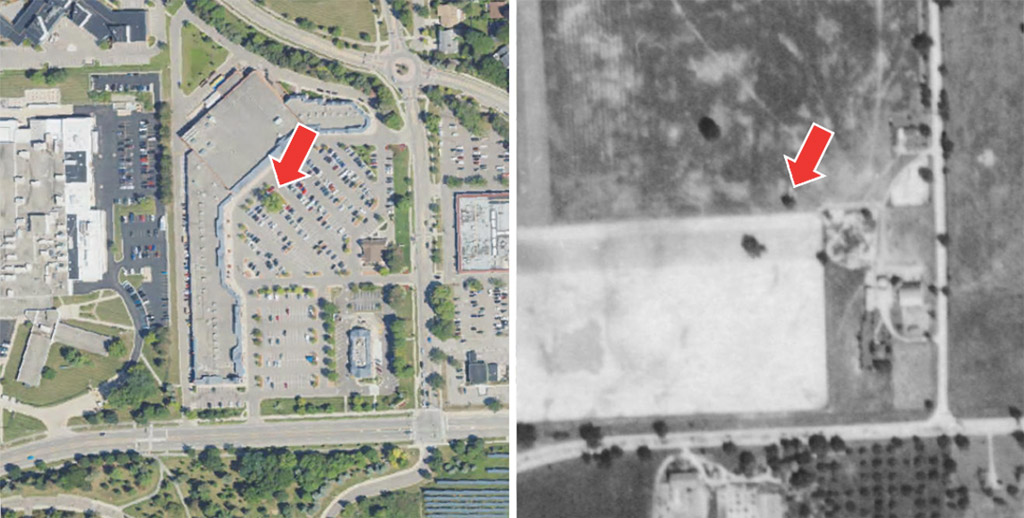
In its retirement from rural life, this fortunate survivor now receives the regular care of a corporate gardener, and the occasional visit by the curious child. This little girl, who has decided to celebrate a warm, late winter day by playfully scrambling up to run a circle around its retaining wall, probably has no idea that she is circling an ancient totem of a former farm field — and even less that she is spontaneously performing a maypole dance by doing it.
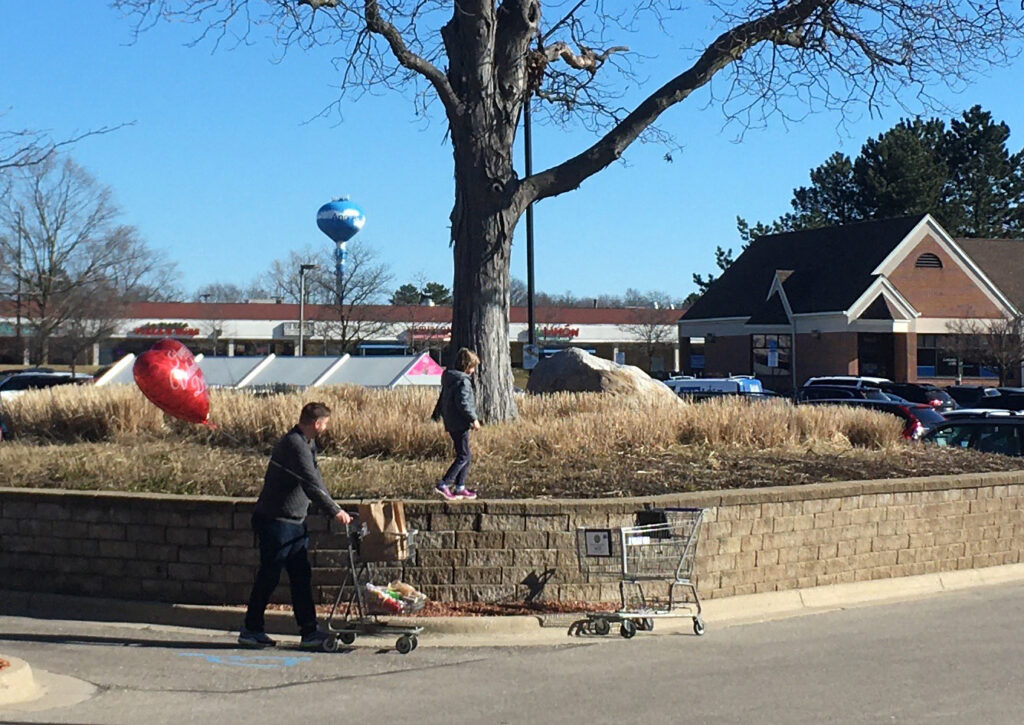
Inspired by this intrepid explorer, I later returned and risked the wrath of mall security by scrambling up to the tree and measuring its trunk. With a circumference of 6 feet 11 inches and a growth factor of 7.5, its diameter of 26-1/2 inches suggests an age of about 200 years. So it’s a reasonable guess that this tree has been here since the 1820s.
No going back
Another thing that this particular hickory can teach us is the uncomfortable fact that development is often not reversible. It is easy to assume that when this shopping center someday undergoes its inevitable decline as a commercial site, the pavement can simply be pried up and carted away, leaving this property to take up where it left off, as farmland. But the “raised bed” surrounding this hickory tells us all we need to know about that idea.
Because a mature tree cannot be raised or lowered, the base of the tree reveals the original level of the ground — about three feet higher than the parking lot. That is, the topsoil and even much of the subsoil of this former farm is long gone, scraped up and carted away — probably sold as fill for another project, or irreversibly mixed together to form the grassy knolls that surround the property. It’s possible that the only fertile topsoil that is left in the entire fifteen acres of this development is bound up in the roots of this tree.
But standing for a moment in the right kind of light on a slow shopping day, the presence of a few wayward weeds not yet plucked by the gardener helps us imagine the peaceful, shady scene that once prevailed here, shading not the abandoned shopping cart but the weary ploughhorse, perhaps, or a rural summer picnic.
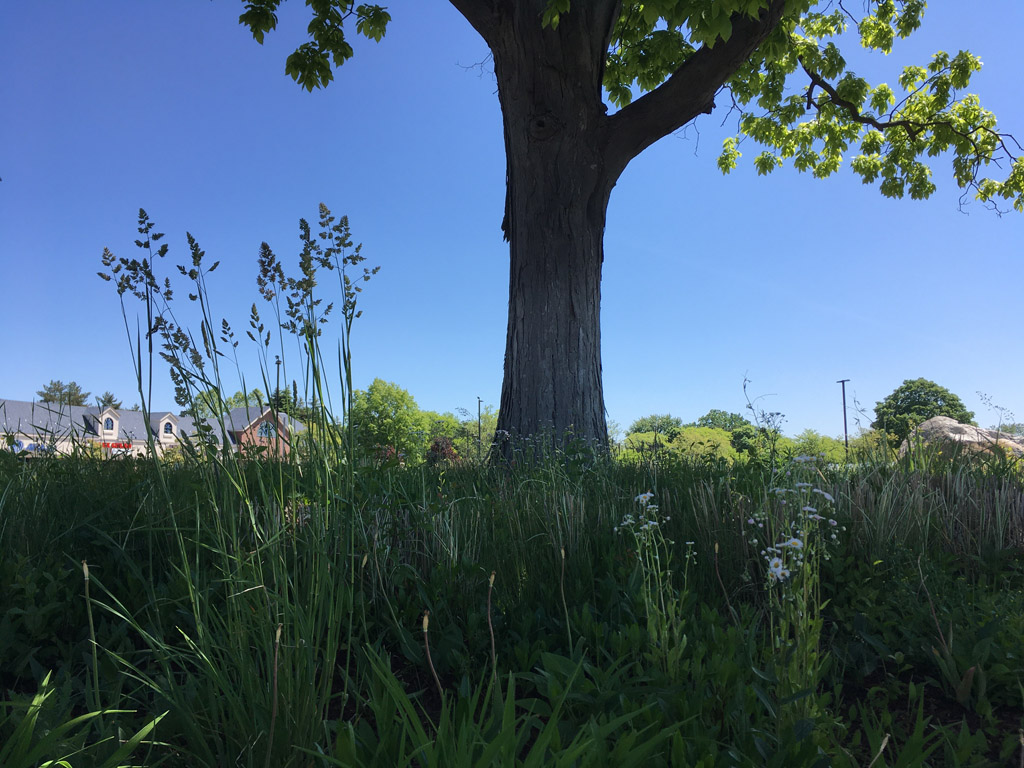
Are there others?
That particular tree was easy to identify because I already knew its history. But could there be others of a similar age, undiscovered and unappreciated? If there are, we might be able to detect them by looking at old aerial photos. Any tree that was big enough to show up on a blurry aerial photo of long ago must have been quite mature at the time — and if it is still there, it has a chance of being a real champion today. Let’s give it a try.
Comparing the general vicinity of the Traver Village neighborhood to its 1940 version, it seems that almost nothing has been untouched by commercial activity. A visitor will see that not only building construction, but aggressive grading and compulsive mounding-up of useless grassy berms has altered the landscape beyond recognition.
However, a careful comparison identifies one tree that might still remain, improbably nestled in an interior corner of an apartment complex. Could it be the same tree? It’s not far away. Let’s take a little stroll and find out.
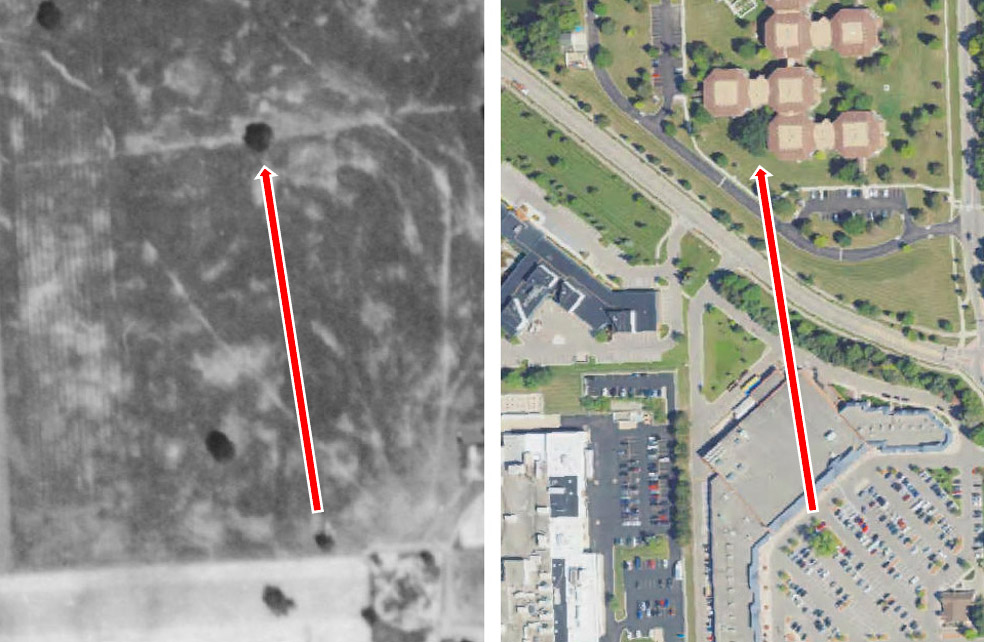
Investigative exploring
We park in the Kroger lot, as if we are about to shop. But rather than entering the store, we walk as nonchalantly as possible around to the rear, where we are immediately confronted by a steep, grassy berm, that seems to be actively denying our curiosity. But we climb over it, and descend to an immaculately paved and striped street, lined by yet another green and perfect mound. We briefly think of Teletubbies, and wonder if their creator was from Ann Arbor. But peeking out from above the mound, we are distracted by the spreading crown of what is obviously a tree like no others in the vicinity. Could this be it?

Climbing over and down, and across another street, we meet our quarry. It is a mammoth oak, worthy of Sherwood Forest. Its size and scale is proof enough that it can only be the same tree seen in the aerial photo of 83 years ago.

Since then, it seems to have sidled up unusually close to an apartment building, with several large field boulders in tow. No doubt the residents of the southwest quadrant of Parkway Meadows Apartments appreciate its shade and stately presence, but I wonder how many of them fully appreciate the past lives of this tree, and the improbability of its survival.
And how old is this tree? On a quiet Sunday afternoon, I parked in a nearby lot and walked down into the valley to hug it with a tape measure. The leaf suggests that it’s a variety of white oak, possibly a swamp white oak, giving it a growth factor of about 5. With a circumference of 13 feet and 11 inches, its diameter of 53 inches suggests an age of something like 265 years — and a birthday in the 1750s.
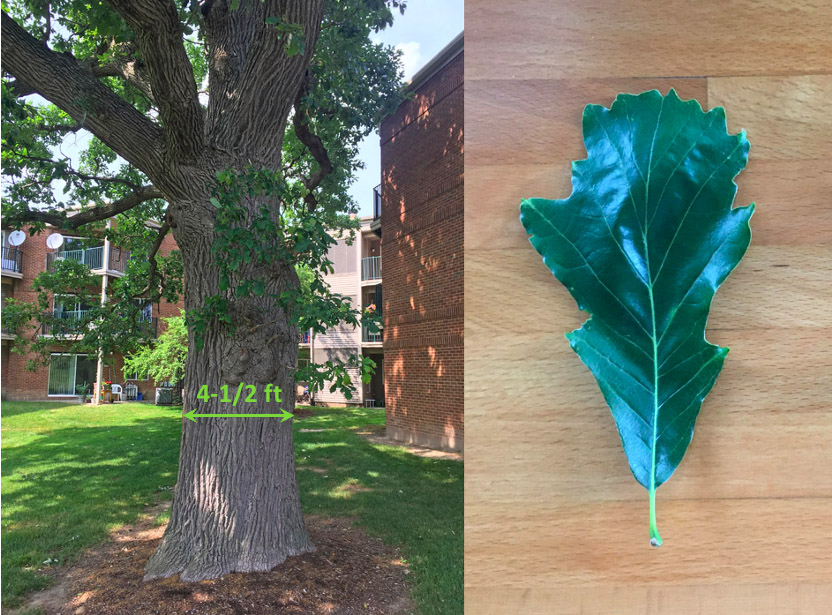
Absorbing the scene
Again, one can perceive the large amount of grading that has taken place in the vicinity by looking at the base of the tree, whose level could not have changed. I took the previous photo from atop the large berm on which Sandalwood Circle was constructed, giving the impression that the tree has always resided in a valley. But likely enough, the entire expanse between this tree and the Kroger hickory was originally flat, as hard as that is to imagine today.
In fact, only from one point along Huron Parkway is it still possible to see these two old companions in a single scene. It takes a strong imagination to mentally erase the clutter of the present and resurrect the scene that once was. But that’s the point. When we squint our eyes and successfully imagine a flat field of wheat while keeping these two trees in sight, we have allowed these trees to lend us some portion of their unusually broad purchase on the passage of time. These two trees have been visible together at approximately the same size since long before most of us were born — and in younger form, perhaps even back to the 1820s, if we have guessed the hickory’s age correctly.
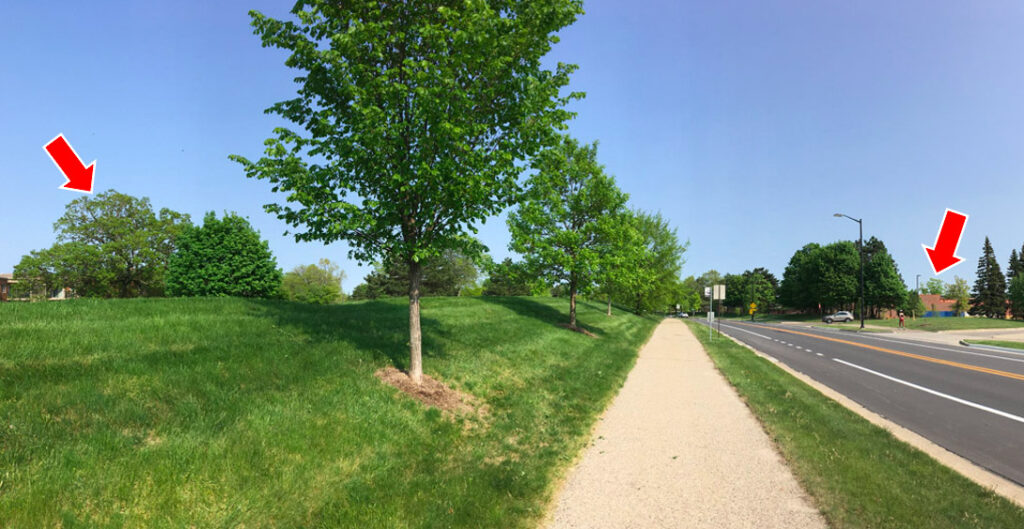
There could be cows down there
Below we see the large spread of a 1940s farmer near Ypsilanti, Michigan (at Harris and Grove Roads). This farmer definitely believed in the value of the solitary tree, many of which are quite randomly sprinkled over the sprawling terrain. There could be cows down there, enjoying the shade; but the linear features make me think these are crop fields, farmed rather intensively yet permitting the occasional obstruction of dozens of solitary trees.
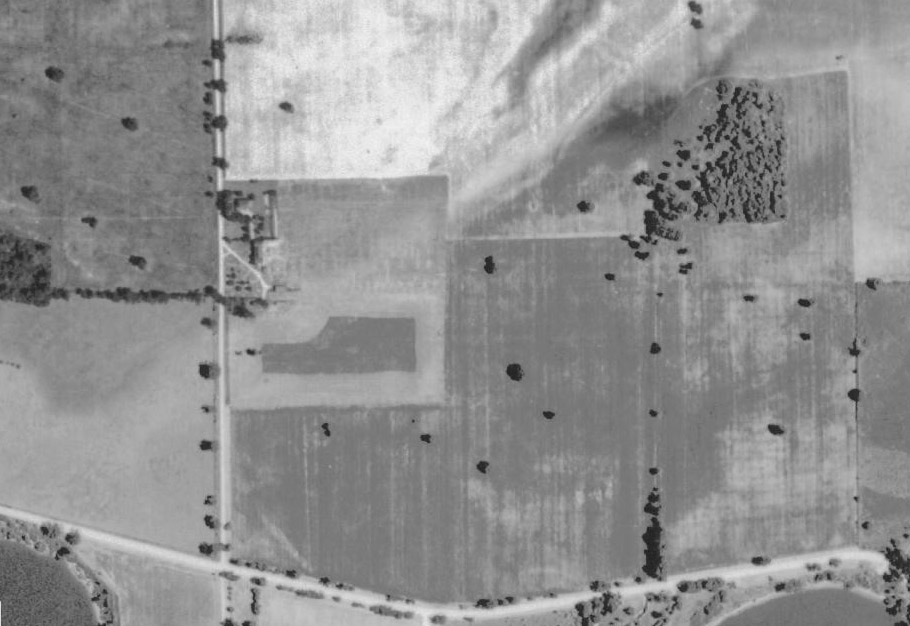
But by 1960: wow, where did all those people come from? What a coincidence that they all decided they needed a new house at the same time, and decided to build it in the same place. Or something like that. Anyway, it’s not looking good for those trees. I’m guessing they were not part of the developer’s business model. Would any of them go on to survive?
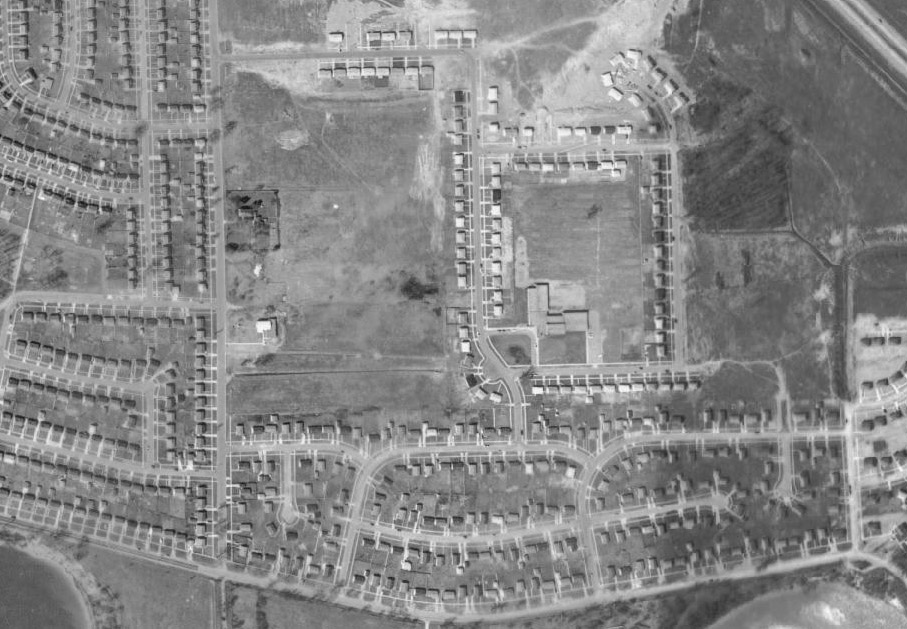
If we look closely at a modern photo and compare it to 1940, we can find some evidence that some of the trees might, miraculously, have slipped through the cracks. Below I’ve selected three that seem like they might appear in both the 1940 photo and in 2022.
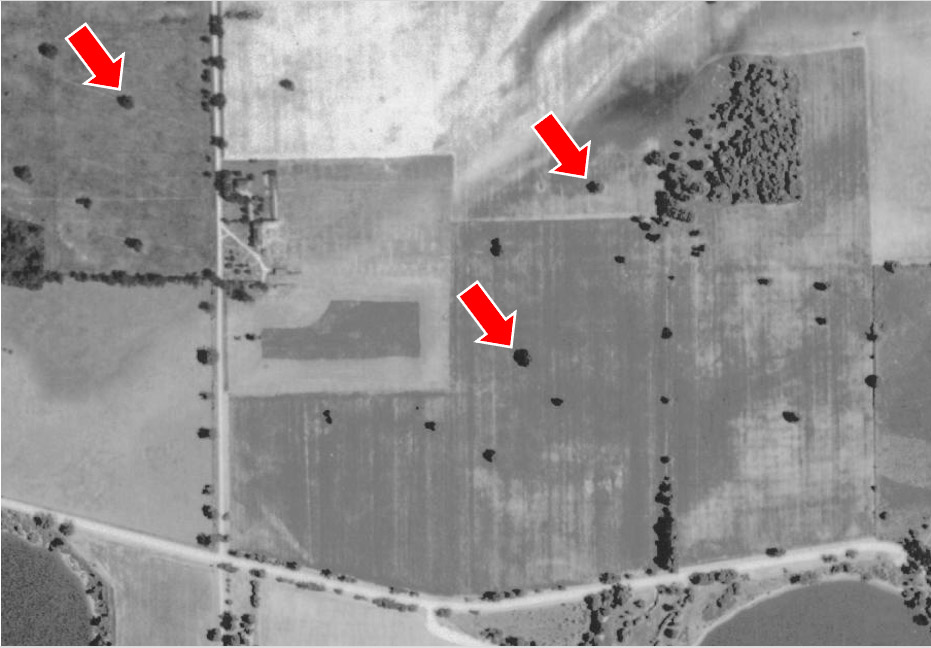
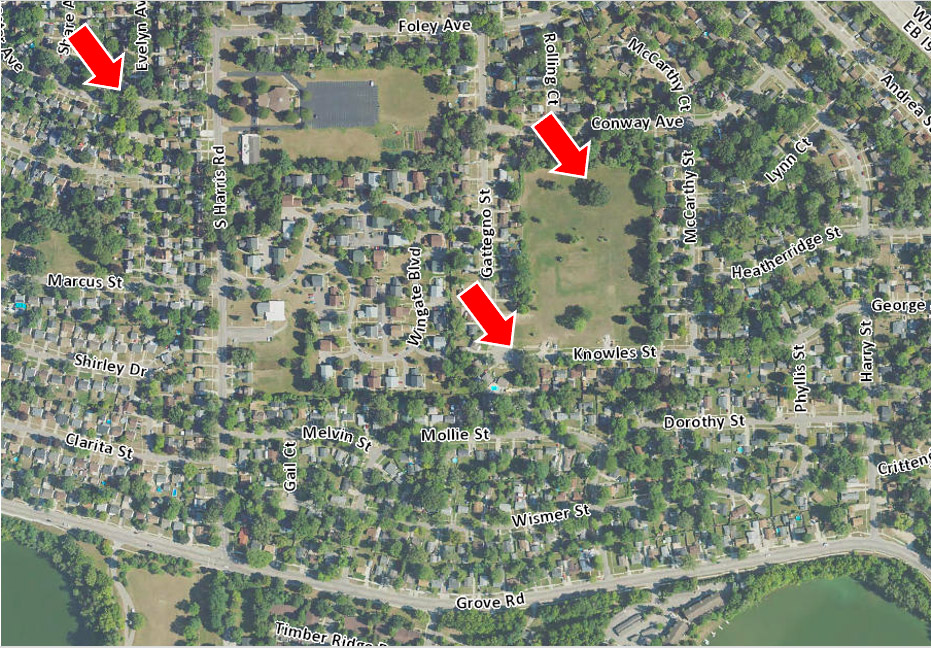
But the photos are indistinct, and it’s anybody’s guess if these are really the same trees. So I went to the site to find out.
Shortly after it was constructed, this neighborhood must have been landscaped with silver maples, because the area is now filled with large, mature specimens of perhaps 50 or 60 years. Silver maples are good at looking much older than they are, because they grow fast, and their tortured trunks readily attain a tremendous girth. On this leafless winter day, how could I tell the ancient from the merely large? I was beginning to get discouraged.
But finally, as I approached the corner of Evelyn and Lester Avenues, I saw it — and it was unmistakable. This was an ancient field tree, packed up and gone to town.

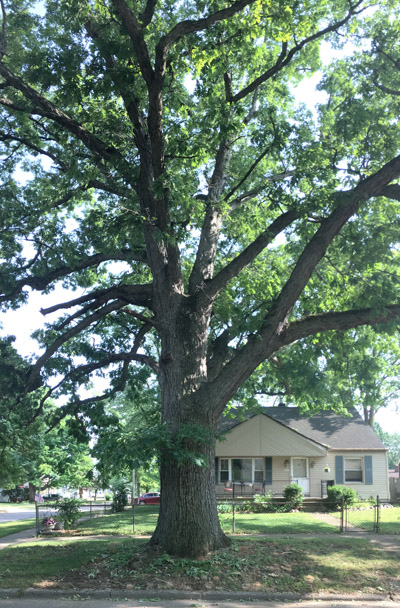
This otherwise unassuming tree was a rather enormous oak that obviously must have predated the development by a century or more. Its sheer scale could be more easily conveyed if a person were in the picture, but alas, I was alone.
In June I came back and measured the tree. A friendly couple happened by and helped me hold the tape measure. Another white oak, its circumference of 12 feet, 11 inches and diameter of 49.3 inches gives it an approximate age of 247 years, or a birthday around 1776. Again, these figures are approximate, but it’s as good a guess we can have without coring the tree.
I then moved on to the corner of Knowles and Gattegno Streets. Here was an even grander oak, anchoring another unassuming streetcorner. Other than a few empty branches near the top, it appears to be in good health. Again, the photo fails to capture the mass of this tree. You kind of need to see it yourself — and you should if you can.

And how old might it be? This was certainly the biggest of the lot so far, with a circumference of 16 feet, 11 inches, and a diameter of a whopping 64.6 inches — almost five and a half feet. This gives it an age guesstimate of 323 years — meaning it might date back as far as the year 1700.
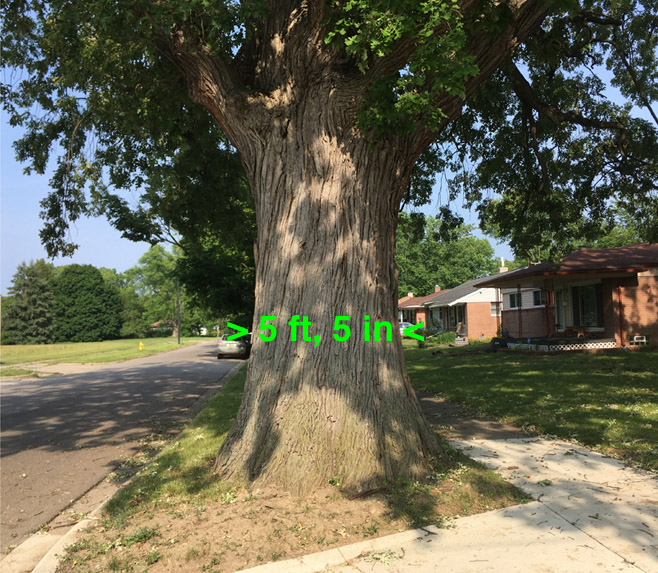
Finally, I walked over to the large vacant lot to the northeast, on Knowles Street between Gattegno and McCarthy. I later found that this was the former site of Kettering Elementary School, demolished in 2010. Conveniently, I found the site to be unfenced and open to public access. If you don’t mind making the day of dozens of barking dogs in the backyards of the many homes that border the site, you can walk out here and admire what is one of the most spectacular white oaks you may ever see. Again, it is impossible to capture its majesty in a photo. Here we see my feeble attempt to do so, in both winter and summer scenes.
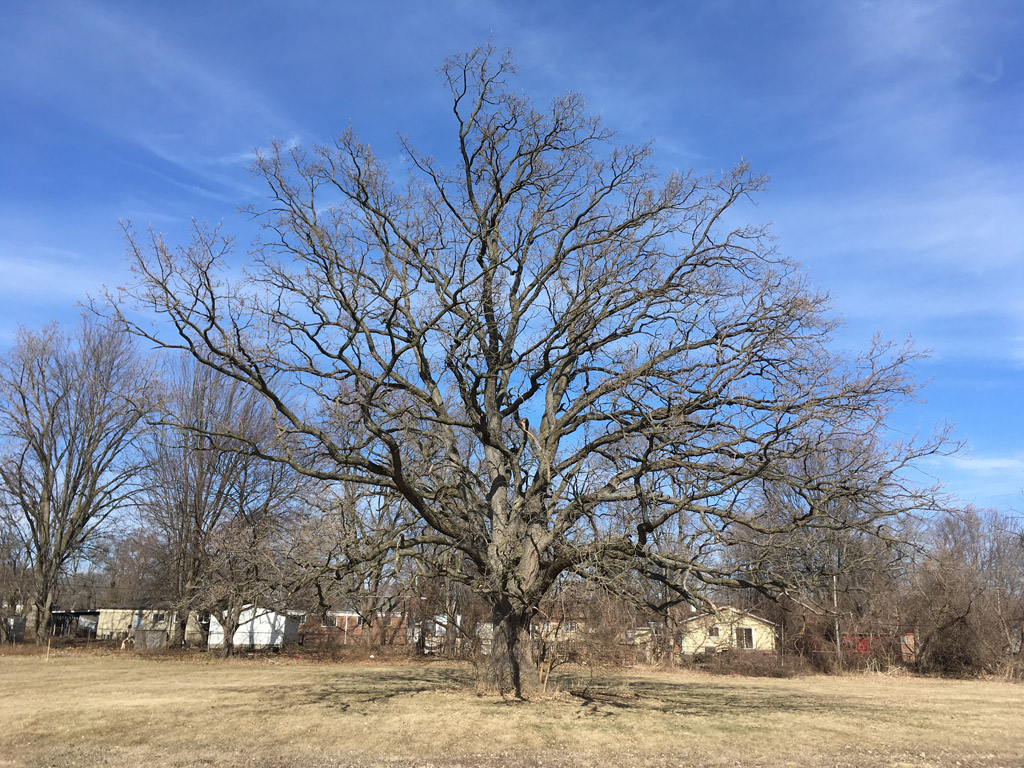
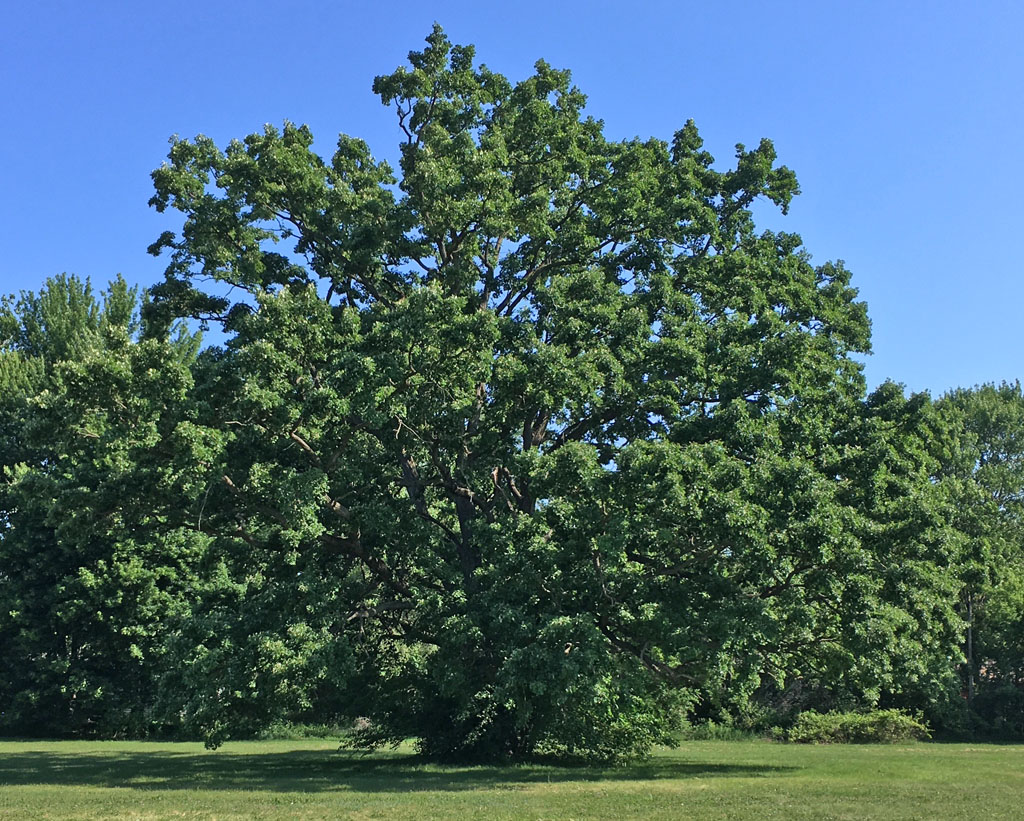
Is this the champion? I returned on a sunny June day to measure it. Unfortunately, since the closure of the elementary school, this tree no longer benefits from the diligent work of Groundskeeper Willie, and it shows. Its trunk was surrounded by a thicket of invasive mulberry and buckthorn, which made stretching the tape nearly impossible, but became the least of my worries after I discovered the lush garland of poison ivy that I was brushing against. I survived. With a circumference of 15 feet, 11 inches, this white or bur oak could be in its 300th year, possibly born in the 1720s. It was edged out in apparent age by Knowles & Gattegno, but it easily wins in sheer grandeur — and cantankerousness.
There could be many more ancient trees to be found in this quiet part of Ypsilanti, and in many other places around the country. I wouldn’t want to hog all the fun, so I’ll leave this as an exercise for the reader.
And I have no idea why all of my measurements ended in 11 inches. I must have been a year too early.
By our nature, we tend to sense the passage of time only on an incremental basis, as it forms into the moments and hours that meter our everyday lives. It is upon this interface that our consciousness most often rests, and often inspires the wise to use it as deliberately as possible:
In any weather, at any hour of the day or night, I have been anxious to improve the nick of time, and notch it on my stick too; to stand on the meeting of two eternities, the past and future, which is precisely the present moment; to toe that line.
– Thoreau
Yet if the meeting of two eternities that is our consciousness is indeed as remarkable as it seems, it is because we are the outcome of all that has gone before, and a cause of all that will come. To give this moment its due significance requires us to sense the weight of time’s accumulation across generations and centuries, which in turn requires a broader perspective than to merely live in the moment.
The improbable presence of these ancient yet undisturbed trees gives us an opportunity to grasp the passage of time on a scale much longer than would normally be afforded by either the length of our own lives or by our romance with the passing moment. Whether in a field unaffected by time, or in a landscape irrevocably altered by it, in them we can grasp something of where we have been and where we are going. For only by contrasting stability with change can we begin to see how much of this world has already been lost in the span of our own brief life — and remind ourselves that in every passing moment, we are not only a recipient of the past, but also a determinant of the future.
Article and photos Copyright 2023.
To be notified of new articles, visit https://whatshallweweird.com/subscribe/
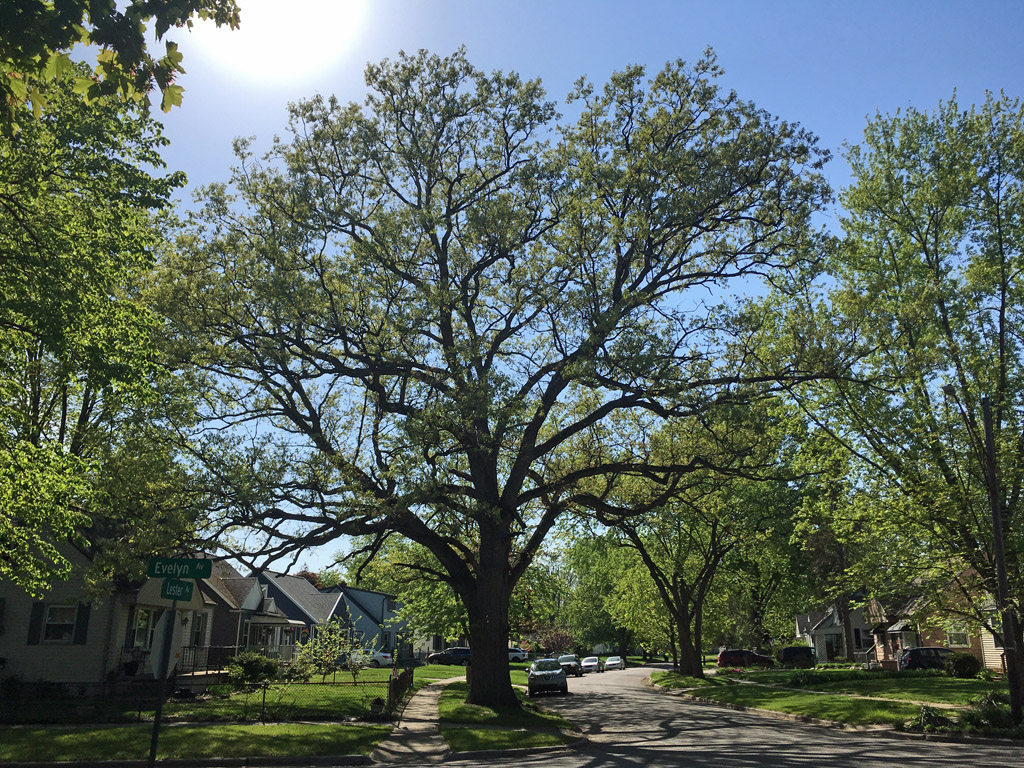


3 Comments
Kythé Mackenzie
once again , you are writing on a subject that interests me. Here in SW France I find the treatment of old trees distressing. They grow easily so they are treated with no respect what so ever.
Andrea Sims
I just found your site and am so enjoying your writing about the history and nature of where I live. I have often wondered about the oak trees in Ford Lake Park at the corner of Huron River Drive and Tuttle Hill Rd. I had not heard of the growth factor ratio before, but now I want to measure those oaks and guess how old they might be.
Mike
Thanks for reading Andrea! Yes, there are a lot of trees around here that deserve to measured and dated – there are still a lot I’d like to learn about. Let me know if you find any old ones!